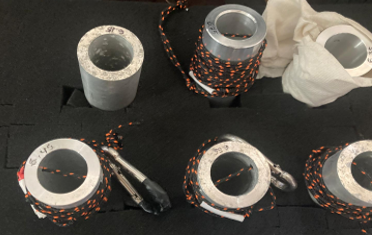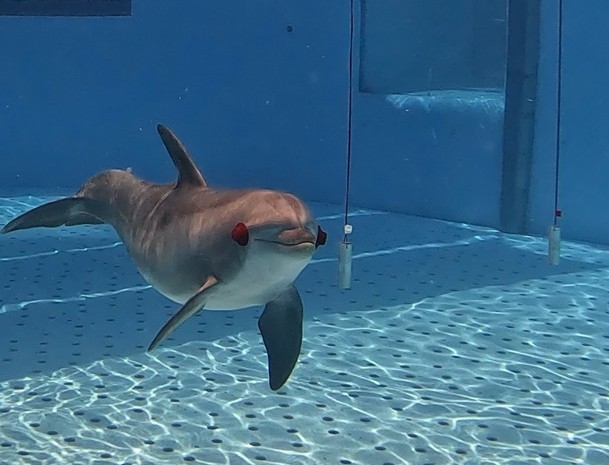Two dolphins, Aquille (male) and Clara (female), were trained to perform a discrimination task between two targets while wearing gelatin eyecups. The eyecups block the visual input and ensure that they rely solely on their echolocation.


The targets were 13 aluminum cylinders, all of them with the same outer diameter and length, but different wall thicknesses.
- Standard cylinder: The one the dolphins were required to choose in every trial. It had a wall thickness of 6.45 mm.
- Comparison cylinders: The other 12 cylinders had wall thicknesses that differed from the standard cylinder by ±0.05mm, ±0.1mm, ±0.3mm, ±0.4mm, ±0.6mm, +0.7mm, -0.9mm.
The standard and the comparison cylinders were suspended in the pool parallel to each other, submerged to a 1 m depth and 13 m away from the dolphin and trainer.
Whether the standard cylinder was presented to the right or to the left was decided by a pseudo-random table, with the restriction that the same position was never repeated more than twice in a row.
A GoPro 9 camera was positioned above the pool to have bird view images of the animal’s swimming behavior during the trials


Before starting the trials, the trainer placed the gelatin eyecups on the dolphin’s eyes.
The dolphin had to swim and select one of the cylinders by touching it with its rostrum.
- If the choice was correct, the trainer blew a whistle, signaling the dolphin to return to the starting position to receive a fish reward.
- If the dolphin selected the incorrect cylinder, the pole with the cylinders was moved out of the water, and the dolphin swam back to the starting position without receiving a reward.
25 trials were preformed for each cylinders. A total of 300 trials were performed with Aquille and a total of 200 trials with Clara